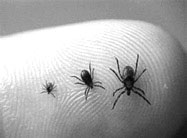Writer
Hank StelzerAccording to the U.S. Centers for Disease Control and Prevention (CDC) and the American Lyme Diseases Foundation, the chance of contracting Lyme disease (LD) in Missouri is rare. It’s also rare in Florida. But back in the summer of 2000, I beat those odds and ran into that rare tick carrying the disease. It was not fun.
My symptoms were a panoply of ailments that ranged from pedestrian joint pains to unexplainable migraines and chest pains; the latter of which landed me in the cardiac unit at Sacred Heart in Pensacola, Florida. Perplexed by my sudden run of bad medical luck, my doctor and I started retracing my steps.
In the course of our discussion, I mentioned a hypersensitive reaction to a bug bite I sustained on my right shin about a month before my medical maladies began. It was a small red spot with a distinct red ring around it; about the size of a quarter. At the time I did have the passing thought that it might be Lyme disease. But since it did not look like posted, textbook images and since I could not find a tick, I did not give it another thought. Besides, who gets a tick bite on their shin?
Having just encountered his first case of Lyme disease less than a month earlier, the doctor ordered the serological test. In the meantime, he put me on a four-week course of antibiotics as a precaution. The test result was inconclusive, but after the treatment I was free of symptoms and have had no problems since. I was lucky we figured it out and I was treated early. Some people are not so lucky and experience chronic lifelong health issues.
How is Lyme disease contracted?
The spirochetal agent of Lyme disease, Borreliaburgdorferi, is transmitted to humans through a bite of a nymphal stage deer tick (Ixodes scapularis). Many kinds of ticks will bite people, but only I. scapularis (I. pacificus on the West Coast) carries the disease. Adult stage ticks are about the size of an apple seed. Nymphs are tiny, about the size of the head of a pin.

Developmental stages of the deer tick. Nymph on the left; adult on the right.
Your chances of contracting LD are greatly reduced if you remove a tick within the first 48 hours. Generally, if you discover a deer tick attached to your skin that has not become engorged, it has not been there long enough to transmit the LD spirochete.
Is Lyme disease in your area?
LD is spreading slowly along and inland from the upper east coast, as well as in the upper Midwest. LD has been found in every state, so if you spend time outdoors it is best to take precautions.
Take these precautions
Do a systematic, whole-body exam each night before going to bed. Performed consistently, this ritual is the single most effective current method of prevention of LD. Keep in mind that nymphal deer ticks are the size of poppy seeds; adult deer ticks are the size of apple seeds.
Wear enclosed shoes and light-colored clothing with a tight weave.
Clothes can be sprayed with either DEET or permethrin. Only DEET can be used on exposed skin, but never in high concentrations; follow the manufacturer’s directions.
Avoid sitting directly on the ground.
Symptoms
The early symptoms of LD can be mild and easily overlooked. The first symptom is usually an expanding rash (called erythema migrans, or EM) which is thought to occur in 70-90 percent of all cases. An EM rash appears either as a solid red blotch or a bull's-eye and appears three to 30 days after disease transmission.
Ticks prefer body crease such as the armpit, groin, back of the knee, and nape of the neck. Rashes will therefore often appear in (but not restricted to) these areas.
Around the time the rash appears, other symptoms such as joint pains, fever, and fatigue are common, but they may not seem serious enough to require medical attention. These symptoms may be brief, only to recur as a broader spectrum of symptoms as the disease progresses.
As LD progresses, a number of other symptoms including severe fatigue, a stiff aching neck, and tingling/numbness in the extremities or facial paralysis can occur. The more severe, potentially debilitating symptoms of later-stage LD may occur weeks/months or in a few cases, years after a tick bite. These can include severe headaches, painful arthritis and swelling of joints, cardiac abnormalities and central nervous system disorders.
Diagnosis
If you think you have LD symptoms, you should see your doctor immediately. LD is difficult to diagnose because the disease mimics many other diseases and there is no definitive test for it at this time. The EM rash is a specific feature of LD, and treatment should begin immediately. If you have symptoms consistent with early LD and suspect recent exposure to a tick, present your suspicion to your doctor so he or she may make a more informed diagnosis.
Information for this article from the American Lyme Disease Foundation (ALDF) website, http://aldf.com, and the Tick Management Handbook, Bulletin 1010, CT Agricultural Experiment Station.